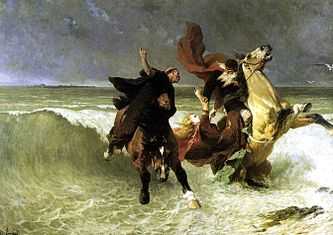Gradlon

Gradlon the Great (Gradlon Meur) was a semi-legendary 5th century "king" of Cornouaille who became the hero of many Breton folk stories. The most famous of these legends is the story of the sunken city of Ys. He is supposed to have been the son of Conan Meriadoc.
The legend
Gradlon and Malgven
According to some legends, he was in love with a magician called Malgven. Gradlon had many ships he used to wage war against the faraway countries of the North. An outstanding strategist, he won most of the battles and pillaged the vanquished, amassing great wealth.
One day, his sailors tired of fighting and refused to continue to lay siege to a castle. The sailors returned home and he remained alone in the North. When he was alone he saw a red-haired woman: Malgven, Queen of the North, standing in front of him. She told him, "I know you. You are courageous and skillful in fighting. My husband is old; his sword has rusted. You and I are going to kill him, then go to your country of Cornouaille." They killed the king of the North and went on Morvarc'h ("sea horse" in Breton), Malgven's magical horse. It was black, spit fire from its nostrils and was able to gallop on the sea. They caught up with Gradlon's vessels, but the approach of Morvarc'h caused the fleet to flee.
The return trip and the Dahut's birth
Gradlon and Malgven remained long at sea, so Malgven gave birth to a daughter, Dahut. According to some versions of the story, giving birth killed the queen. According to other versions, she didn't die but, some time after the birth of Dahut, she asked Gradlon what he thought about Dahut. He responded "I already cherish her as I cherish you." Malgven announced that Dahut's face would keep the appearance of hers, so she would not be forgotten by him, because it was time for her to return to her world. She added that they would see an island shortly after, and Gradlon should let her go there; otherwise they could never see the earth again. Soon after, they saw an island and there Malgven was left alone.
Shortly after, Gradlon arrived in Cornouaille with Dahut, but without Malgven.
Ys
Later, Dahut had a key role in the story of Ys, a city built below sea level and protected by a gate that kept the sea out. Dahut turned the city into a place of sin and debauchery. One night she stole the key to the gate from her sleeping father and drunkenly opened the gate. Gradlon awoke and rescued his daughter from the drowning city on his magical horse, but her sins kept dragging them into the sea before he could reach land. In the end Saint Winwaloe told him to drop his daughter. She was swallowed by the sea, becoming a form of siren or morgen, luring men to destruction.
Gradlon re-established his rule in Quimper, before eventually retiring as a hermit.
Descendants
At Gradlon's death, his son Salomon the 1st succeeded him, then his grandson, Aldrien.
Dahut appears again in the Arthurian legend of King Mark.
Historicity
According the sources, several historical Gradlons existed: Gradlon Meur is cited in a cartulary of Landévennec, but there is also a Gradlon Flam and Gradlon Plueneuor (Plonéour). They are generally classified as consul, which can be understood as the count - as the Latin texts translate the Breton title of mac'htiern by "tyrant". They would have most likely lived between the 5th and 9th centuries.
In the Gallo-Roman era, the capital of Osismes - predecessors of Cornouailles, Trégorrois and Léonards - was Carhaix. And if there was a city on the Odet it was not yet Quimper, but a little downstream in the current Locmaria quarter.
See also
![]() Media related to Gradlon Mawr at Wikimedia Commons
Media related to Gradlon Mawr at Wikimedia Commons
References
- ↑ Bonnet, Philippe. Quimper : la Cathédrale. Paris: Zodiaque, 2003.